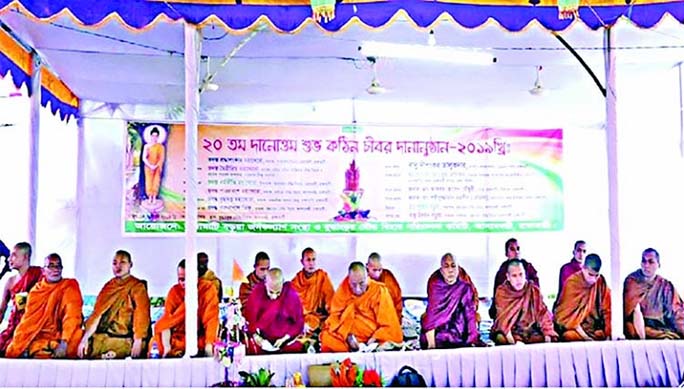
A Correspondent :
Kathin Chibar Dan, a month-long religious festival of tribal Buddha community of the Chattogram Hill Tracts, started from Buddhangkur Temple premises in Rangamati on Monday with much enthusiasm.Kathin Chibor Dan’ means ‘Offering of the Difficult Monk’, an annual colourful festival where new robes are donated to the monks.
Buddhangkur Temple and Rangamati Barua Janakalyan Songstha jointly organised the festival that include Panchasheel Grohon, Buddha Puja, Ashta Porishkar and Pradip Puja, reports UNB.
On the first day, a religious meeting was held chaired by Dharmashava Parbatta Bhikhkhu Songho president Sraddhalangkar Mohatherar where principal of Buddhangkur Temple Karunapal Bhikhkhu read out the Mangalacharan.
Seeking divine blessings of Lord Goutam Buddha for lasting peace and prosperity for the people of all communities in the country, the Buddhists will light candles and offer prayers in the temple.
The historical background of the robe offering is mentioned in the Vinaya Pitaka text. When the Buddha was dwelling at Jetavana Vihar in Shravasti, a group of 30 monks visited him. The Buddha noticed their worn out, threadbare robes. It is said that at the time, monks used to wear robes sewn together from pieces of cloth collected from different places such as cemeteries, discarded in the street, and rubbish heaps.
To address this, the Buddha granted permission for the monks to celebrate the Kathina ceremony-with several rules, such as only those monks who have successfully completed the rains retreat may receive a Kathina robe.
Legend said that Gautama Buddha came to the region to spread Buddhism, and it was speculated that one or two individuals became monks to follow in his footsteps. However, Buddhism did not gain much support until the reign of Asoka when Buddhism gained a toehold.
The Pala Empire that controlled the Indian subcontinent spread many Buddhist ideologies in modern Bangladesh and built many monasteries such as the Mahasthangarh and the Somapura Mahavihara. During the Pala Dynasty, a famous teacher named Atisha was born in the city of Bikrampur and spread Mahayana Buddhism.
Chandra Dynasty’s Puranchandra and Subarnachandra adopted Buddhism, as did their successors Trailokyachandra and Srichandra who ruled Harikel and Chandradwip (Barisal).[3] The Khadga Dynasty was a Buddhist dynasty of kings that carried the surname Bhatt. They made several temples and monasteries. King Rajabhata was for example a very committed Mahayanist Buddhist.
Kathin Chibar Dan, a month-long religious festival of tribal Buddha community of the Chattogram Hill Tracts, started from Buddhangkur Temple premises in Rangamati on Monday with much enthusiasm.Kathin Chibor Dan’ means ‘Offering of the Difficult Monk’, an annual colourful festival where new robes are donated to the monks.
Buddhangkur Temple and Rangamati Barua Janakalyan Songstha jointly organised the festival that include Panchasheel Grohon, Buddha Puja, Ashta Porishkar and Pradip Puja, reports UNB.
On the first day, a religious meeting was held chaired by Dharmashava Parbatta Bhikhkhu Songho president Sraddhalangkar Mohatherar where principal of Buddhangkur Temple Karunapal Bhikhkhu read out the Mangalacharan.
Seeking divine blessings of Lord Goutam Buddha for lasting peace and prosperity for the people of all communities in the country, the Buddhists will light candles and offer prayers in the temple.
The historical background of the robe offering is mentioned in the Vinaya Pitaka text. When the Buddha was dwelling at Jetavana Vihar in Shravasti, a group of 30 monks visited him. The Buddha noticed their worn out, threadbare robes. It is said that at the time, monks used to wear robes sewn together from pieces of cloth collected from different places such as cemeteries, discarded in the street, and rubbish heaps.
To address this, the Buddha granted permission for the monks to celebrate the Kathina ceremony-with several rules, such as only those monks who have successfully completed the rains retreat may receive a Kathina robe.
Legend said that Gautama Buddha came to the region to spread Buddhism, and it was speculated that one or two individuals became monks to follow in his footsteps. However, Buddhism did not gain much support until the reign of Asoka when Buddhism gained a toehold.
The Pala Empire that controlled the Indian subcontinent spread many Buddhist ideologies in modern Bangladesh and built many monasteries such as the Mahasthangarh and the Somapura Mahavihara. During the Pala Dynasty, a famous teacher named Atisha was born in the city of Bikrampur and spread Mahayana Buddhism.
Chandra Dynasty’s Puranchandra and Subarnachandra adopted Buddhism, as did their successors Trailokyachandra and Srichandra who ruled Harikel and Chandradwip (Barisal).[3] The Khadga Dynasty was a Buddhist dynasty of kings that carried the surname Bhatt. They made several temples and monasteries. King Rajabhata was for example a very committed Mahayanist Buddhist.

